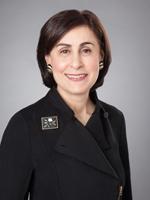“Never Be Satisfied Until We Find Cures,” Q & A with Caren Heller, MD, Chief Scientific Officer, Crohn’s & Colitis Foundation
Published: July 28, 2023
In the world of healthcare and research, there are individuals who stand out as true pioneers, disruptors, and visionaries. Caren Heller, MD, MBA, Chief Scientific Officer of the Crohn's & Colitis Foundation, is undoubtedly one of them.
With extensive experience in the pharmaceutical and healthcare industries and academic medical centers, Dr. Heller joined the foundation with a clear mission - to fund and promote efforts that would lead to new treatments—and eventually cures— for Crohn's disease and ulcerative colitis.
As the Foundation's Chief Scientific Officer, Dr. Heller is responsible for all mission-related activities, including research efforts and patient and provider support and education programs. Dr. Heller is retiring this summer and reflected on her close to 10-year tenure at the Foundation and the groundbreaking accomplishments she has achieved in driving research findings from publication to patient care.
Can you tell us about your goals when you joined the Crohn's & Colitis Foundation and how they measure up with everything you've accomplished?
When I joined the Crohn's & Colitis Foundation, I saw the need to create a comprehensive pipeline that went from early research discoveries all the way to new treatments and cures. At the time, the focus was mainly on investigator-initiated awards and research initiatives, but I wanted to expand beyond that. With initiatives like IBD Ventures, the Foundation’s dedicated funding mechanism that supports product-oriented research and development, we have been able to leverage our earlier investments to propel promising research findings toward clinical applications. For example, we invested in genetics research, identifying PAI-1, a potential key gene upregulated in IBD patients, and progressed it through our incubator for further development that is progressing towards becoming a new therapeutic candidate.
Through IBD Ventures, researchers developed an oral drug that blocks the GCPII protein, which contributes to inflammation and a leaky gut barrier in IBD patients. This drug is now moving toward clinical trials. We also funded a novel wearable sensor, similar to a bracelet, which can measure biomarkers in sweat that indicate flares in IBD patients. Additionally, our Chronic Pain in IBD Initiative is making progress in understanding and treating abdominal pain in the more than 30% of IBD patients who are considered to be in remission and yet continue to suffer from chronic pain.
Can you elaborate on how your work helped drive research findings from publication to patient care?
This has been a core aspect of our work at the Crohn's & Colitis Foundation. We understand that publishing research findings is essential to disseminating knowledge, but it cannot be the end goal. We go beyond publications and focus on turning these findings into robust clinical tests and treatments that can be utilized in patient care. For instance, we funded research on prognostic markers for complications in pediatric patients and then are working on translating those findings into a clinical test that can benefit young patients with IBD. We are committed to getting these breakthroughs to the patients who need them most.
Under your tenure, the Foundation launched IBD Plexus. How has this been transformational for IBD research?
IBD Plexus allows researchers to access extensive data from more than 20,000 patients, and so dramatically accelerate their work. Many of these patients have linked bio samples and ‘omics data, like genomics, which can advance research leading to precision medicine. For instance, IBD Plexus data played a pivotal role in a study recently published in Nature Medicine. The study explored whether it could identify a biological signature that could predict which patients would be likely to respond to 5-ASA, a frequently prescribed IBD therapy, as over half of patients usually either fail to respond or lose response over time. The researchers were able to find a signature and validate this finding using Plexus data and so advance the use of a personalized approach to deciding which patients would be likely to benefit from ASA treatment. This important platform cuts years off the research process and significantly accelerates scientific investigation for researchers, getting us closer to advances in precision medicine for Crohn’s disease and ulcerative colitis.
The Foundation has been known for taking risks and pushing boundaries in research. Can you share your thoughts on this approach?
To achieve transformative breakthroughs, we must be willing to take some risks and even embrace the possibility of failure. It's a necessary part of the research process. The Crohn's & Colitis Foundation has always been bold and willing to venture into uncharted territories. While some endeavors may not yield immediate results, this approach has allowed us to make significant progress and lead the field. We've proven that we can deliver meaningful results, and people are eager to collaborate with us because of it. Our commitment to being pioneers and pushing the boundaries is vital for advancing research and ultimately finding cures for these diseases.
What legacy do you hope to leave behind, and what is your message for those continuing the Foundation's mission?
As I step away from my role, I hope to leave behind a legacy of unyielding dedication to our mission. I've always believed in never being satisfied until we find the cures we seek. My personal attitude of pushing the boundaries and striving for more may be considered intense, but it is necessary when facing a chronic disease in need of better treatments. My hope is that those continuing the Foundation's mission will carry forward the spirit of innovation, willingness to take risks, and the drive to make a real difference in the lives of patients. Together, we can lead the field, pioneer groundbreaking research, and bring hope to millions affected by Crohn's disease and ulcerative colitis.
